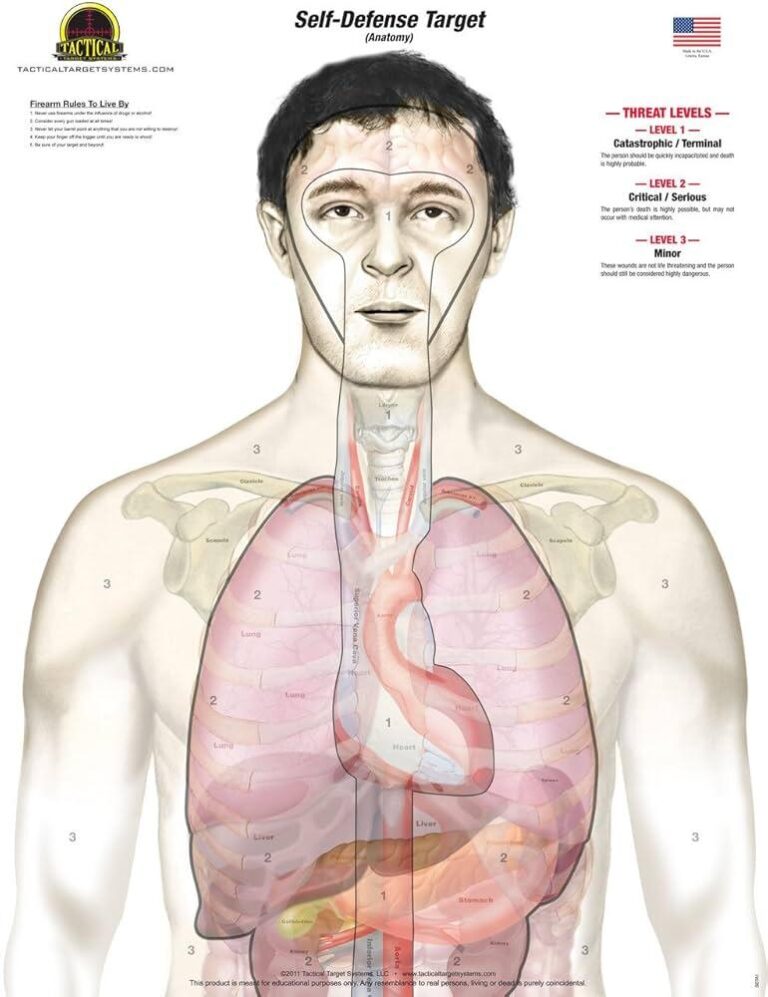Table of Contents
- Key Vulnerable Points on the Human Body for Immediate Impact
- Techniques to Maximize Effectiveness Under Stress
- Legal and Ethical Considerations in Target Selection
- Incorporating Target Strikes into Practical Self-Defense Training
- Final Thoughts
Key Vulnerable Points on the Human Body for Immediate Impact
When seconds count in a critical self-defense situation, targeting specific vulnerable zones on the body can create an immediate and disorienting impact, giving you the precious time needed to escape. Areas such as the eyes, throat, and groin are among the most sensitive spots, requiring minimal force to incapacitate an attacker. A swift jab to the eyes can cause temporary blindness and intense discomfort, while strikes to the throat can disrupt breathing and cause coughing or gasping. The groin, densely packed with nerves, reacts painfully to strikes and forces an aggressor to double over in defense.
Aside from these primary targets, other effective points to focus on include the nose, solar plexus, and knees. The nose is highly sensitive and a strong strike here can cause sudden pain and disorientation, often triggering tearing and difficulty breathing through the nose. Blows to the solar plexus-a cluster of nerves just below the sternum-can wind an attacker momentarily. Meanwhile, targeting the knees with a forceful strike can destabilize an aggressor, reducing their mobility and increasing your chance to flee. Utilizing these areas in a calculated, precise manner maximizes your self-defense effectiveness without requiring extensive strength or technique.
- Eyes: Temporary blindness and intense pain
- Throat: Disrupts breathing and causes coughing
- Groin: Instant sharp pain and nerve impact
- Nose: Pain, tearing, and disorientation
- Solar Plexus: Momentarily winded and breathless
- Knees: Limits movement and causes instability
Techniques to Maximize Effectiveness Under Stress
When adrenaline surges and your heart races, it’s crucial to maintain clarity and precision. One effective approach is to focus on your breathing-deep, controlled breaths help calm the nervous system, allowing for quicker decision-making and steadier movements. Complement this by training your body to react instinctively; repeated practice of striking basic target areas can build muscle memory, so even under intense pressure, your actions become swift and targeted.
Visualizing success before an encounter can also sharpen your focus. Mental rehearsals prime your brain to recognize key moments and appropriate responses. During practice, incorporate drills that simulate real-life stressors such as loud noises or sudden movements; this conditions your mind to stay composed and prioritize critical strikes. Key strategies to keep in mind include:
- Maintain a relaxed but ready posture to reduce wasted energy
- Use short, explosive strikes aimed at vulnerable zones
- Stay aware of your surroundings to avoid surprise and create escape opportunities
Legal and Ethical Considerations in Target Selection
When discussing target areas for self-defense, it is crucial to balance effectiveness with responsibility. The primary goal in any confrontation is to create an opportunity for a safe escape, never to cause permanent harm or engage in excessive force. Always remember that striking vulnerable areas should be done with the intent of incapacitating temporarily rather than inflicting lasting damage. This ethical boundary preserves your integrity and aligns with legal standards that emphasize proportionality and necessity in self-defense situations.
Moreover, understanding local laws regarding self-defense can prevent unintended legal consequences. Many jurisdictions have specific guidelines dictating what level of force is justified when protecting oneself. Striking certain targets, such as the head or throat, may be viewed as overly aggressive depending on the context. To stay within legal and ethical boundaries, consider the following key points:
- Use minimal force necessary to stop the threat and escape.
- Avoid strikes aimed at vital organs unless absolutely required for survival.
- Be aware of your surroundings and the legality of self-defense actions in your area.
- Always prioritize retreat and de-escalation before resorting to physical strikes.
Incorporating Target Strikes into Practical Self-Defense Training
Effective self-defense isn’t just about knowing where to strike but understanding how to integrate these strikes seamlessly into realistic scenarios. Training should incorporate dynamic drills that simulate an attacker’s movement, allowing practitioners to identify and hit vulnerable targets swiftly and with precision. Emphasizing speed, accuracy, and control ensures that these techniques are not only powerful but also safe to execute, reducing the risk of escalation or injury to both parties. Utilizing tools such as focus mitts or padded dummies enhances muscle memory, enabling quicker reflexes when facing real-world threats.
Building situational awareness alongside physical strikes further amplifies the effectiveness of target-focused training. Combining defensive maneuvers with targeted counterstrikes on areas like the eyes, throat, or knees can incapacitate an attacker, making a fast escape possible. Exercises should involve practicing multiple strikes in succession, reinforcing the ability to respond with a combination of moves under pressure. This fusion of tactical mindset and physical execution transforms self-defense training into a practical, confidence-building skill set ready for real-life application.
Final Thoughts
Incorporating knowledge of key target areas into your self-defense practice can make all the difference when seconds count. By understanding where to strike for a swift and effective escape, you empower yourself with practical tools to protect your safety confidently. Remember, the goal is not to engage but to create an opportunity to get away and seek help. Stay safe, stay aware, and continue honing your skills-because preparation is your best defense.Check Our Other Blogs
- StunGun – Your Trusted Source for Stun Guns, Laws, and Self-Defense Tips
- PepperSprayLaws – Your Trusted Resource for Pepper Spray Information
- StunGunLaws – Your Trusted Guide to Stun Gun Legality and Safety



